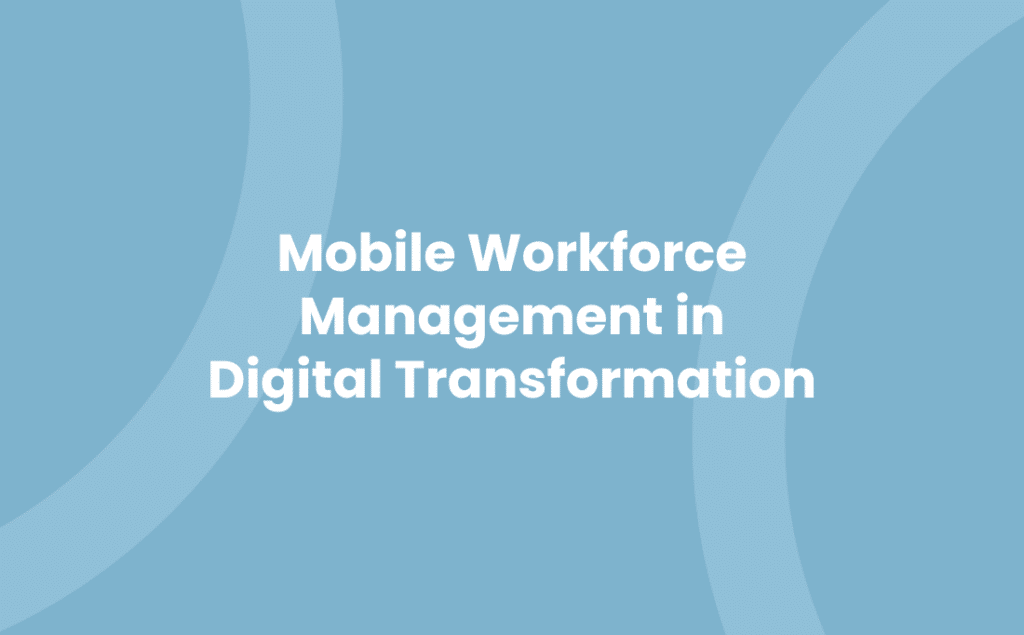Digital transformation isn’t just a buzzword anymore‚ it’s a reality that’s reshaping the way businesses operate. As technology continues to evolve at an unprecedented rate, it’s critical for businesses to adapt and leverage these advancements to enhance their mobile workforce capabilities.
Imagine your team, unchained from their desks, having the freedom to work efficiently from anywhere in the world. This isn’t a distant future scenario, it’s happening now. From streamlining operations to improving collaboration, digital transformation is revolutionising the way we work.
So, buckle up as we delve into the fascinating world of digital transformation and discover how it’s empowering a more efficient and effective mobile workforce. We’ll also explore the challenges that lie ahead and how to overcome them. Because in this digital age, it’s not just about keeping up‚ it’s about staying ahead.
Understanding Digital Transformation
Grasping the concept of digital transformation sets the stage for comprehending its profound impact on mobile workforce capabilities. Digital transformation involves the integration of digital technology into all areas of a business. This results in fundamental changes to how businesses operate and how they deliver value to customers. Unlike standalone technological changes, digital transformation represents a sweeping, company-wide alteration that affects every level of an organisation.
Digital transformation encompasses more than just swapping out old systems for new ones‚ it’s an organisational shift. It permits improvements in business models and strategies, driving changes in leadership, experimentation, and employee engagement. This transformation is not a one-step process nor an end line, rather, it’s an ever-evolving journey that changes as technology advances. Digital transformation influences customer experiences by helping businesses better understand their customers’ needs, optimising interactions to meet these needs and fostering a stronger relationship altogether.
Instrumental in facilitating this shift are digital technologies, which automate and simplify business processes. This allows companies to respond swiftly to market changes or customer demands, increasing their agility and competitiveness. For instance, cloud computing provides scalable and flexible resources, enabling businesses to adapt to fluctuating workloads. Artificial Intelligence, on the other hand, offers data-driven insights, allowing decisions to be informed, strategic and less reliant on guesswork.
These tech-savvy advancements significantly enhance mobile workforce capabilities. They foster remote work environments, granting the possibility to carry out tasks from pretty much anywhere. Tools for project management and collaboration proliferate, enabling teams to communicate more effectively. These technologies aid in maintaining productivity, regardless of geographical location, transforming the face of traditional work structures.
Hence, in understanding digital transformation, focus on the broader picture. It’s not limited to implementing new tech but transforming business models, practices, leadership and culture. It’s an ongoing journey that offers competitive advantages and enhanced mobile workforce capabilities paving the way for becoming a true digital enterprise. Remember, the goal is all about serving customers better, improving operations and advancing your business in a world where digital technology is at the heart.
Enhanced Mobile Workforce Capabilities Explained
Let’s explore more about “Enhanced Mobile Workforce Capabilities” and the role of digital transformation steps in its uplifting. As part of the digital transformation journey, businesses adopt new technologies, creating a ripple effect of improvements across employee productivity and customer service. Let’s unpack this term.
- Flexibility in the Workspace: The capability to work from all locations, at any time, offered by digital advancements has increased productivity significantly. With features like cloud-based document sharing platforms (e.g. Google Drive) and video conference tools (e.g. Zoom), teams can collaborate from various geographical locations.
- Improved Efficiency: Digital apps and AI intelligence streamline work proceedings, eliminating time-wasting activities from routines. For instance, task management apps (like Trello) organise work procedures, and AI-powered CRM platforms automate mundane tasks, providing employees more time for complicated work.
- Robust Communication Channels: Digital transformation is synonymous with improved communication channels. From instant messaging platforms (e.g. Slack) to cloud-based team management suites (e.g. Asana), these digital tools offer a platform for quick, clear, and efficient communication.
- Real-Time Data Access: An enhanced mobile workforce enjoys access to accurate, real-time data. Through this instant data access, businesses keep up with fast-paced market trends and deliver exact insights to customers when needed, significantly improving decision-making processes.
- Increased Security: Commonly overlooked, but vital: digital transformation aids in bolstering enterprise security networks. Encryption tools, secure cloud-storage solutions, and stringent identity verification measures, contribute to a safer digital working atmosphere.
Remember, embracing “digital transformation mobile workforce” strategies requires shifting towards an open-minded approach to technology. A digitally savvy mindset bridges the gap between a regular workforce and an enhanced one, and maintaining that perspective is paramount. By investing in digital tools and integrative tech, businesses take significant strides towards a future of innovation and growth.
Linking Digital Transformation and Mobile Workforce
In today’s changing digital landscape, businesses strive to nurture enhanced mobile workforce capabilities. An essential element of this endeavour revolves around digital transformation. Arguably, it is the linchpin enhancing the potency of a mobile workforce.
Digital transformation, quite simply, refers to the integration of digital technologies into all business areas leading to fundamental changes in how businesses operate and provide value to their customers. With rapid advances in technology, businesses have a multitude of digital tools at their disposal. For instance, cloud computing services offer seamless access to business-critical data anytime, anywhere. Artificial Intelligence streamlines business operations, enabling employees to focus on strategic tasks rather than routine work.
Mobile workforce strategies, such as BYOD (Bring Your Own Device) policies, are a common example of digital transformation in action. These strategies encourage employees to use their personal devices for work purposes, increasing flexibility and productivity.
Moreover, sophisticated project management tools allow teams to collaborate effectively irrespective of their geolocation. This shift towards a more connected, mobile workforce is largely feasible due to digital transformation.
However, the successful navigation of this transformation entails far more than merely adopting new technologies. It requires an organisational shift – a new, digitally savvy mindset. Businesses must be willing to invest in the necessary technology and training, fostering an environment conducive to innovation and digital growth.
With mobile workforce capabilities enhanced by digital transformation, businesses experience improved communication, access to reliable data, increased flexibility, enhanced security, and a significant boost in efficiency. In short, digital transformation drives the mobile workforce, stimulating innovation and growth.
Remember, getting started with digital transformation is easier than it may seem. All it takes is a step in the right direction: adopting one digital tool, launching a single digital project, or simply fostering a digital mindset within your team can set in motion a transformative journey towards becoming a digitally savvy organisation.
Benefits of Enhanced Mobile Workforce Capabilities Through Digital Transformation
Venturing into the digital transformation era, your business stands to reap significant benefits. Progressing digital capabilities through mobile workforce strategies revolutionises the way your organisation operates. The enhancement goes beyond routine office automations or mere data storage.
- Boosted Efficiency: Advanced digital tools facilitate streamlined workflows. Specific applications grant employees the capacity to achieve tasks regardless of location. Instances include project management tools capable of aiding task allocation, thereby optimising time and efforts.
- Superior Communication: Communication platforms, thanks to digital transformation, foster team collaboration, ensuring your staff remain in the loop. For example, video conferencing software paves the way for more dynamic communication, bridging the gap among remote colleagues.
- Robust Security Measures: Digital transformation equips the mobile workforce with next-generation security protocols. Enhanced encryption methods coupled with secure access control mechanisms fortify your company data.
- Profound Data Insights: Artificial Intelligence (AI) stands as an influential tool in mobile workforce strategies, affording deeper understanding of business metrics. Interpret rich data pools and drive decisions that yield competitive advantages.
- Promotes Employee Satisfaction: A well-equipped mobile workforce often correlates with high job satisfaction. Empower your employees with the ability to work flexibly, tailoring their work-life balance to optimal levels.
Remember, digital transformation doesn’t solely remodel infrastructural elements; it engrains a digitally oriented culture within your organisation. Be it proficiently catering to customer demands, keeping abreast with industry trends or ensuring secure robust operations, the intertwined relationship of digital transformation and mobile workforce capabilities paves the path for a future-proof business. This, in return, empowers businesses to remain resilient in rapid market changes, props up sustainable growth and ensures competitive longevity.
Real-Life Applications of Digital Transformation in Enhancing Mobile Workforce Capabilities
Exploiting digital transformation for mobile workforce optimisation is a rising trend among UK’s SME business owners. Concrete applications manifest across various sectors, reconfirming the technology’s potential. Let’s examine a few.
In logistics, routing software employs AI to optimise routes. This application not only curtails fuel costs but also saves drivers’ time‚ enhancing productivity. GPS tracking enables real-time monitoring, providing updates to customers, thereby boosting service quality.
Retail industries are also tapping into digital transformation. Utilisation of mobile point-of-sale devices (mPOS) and mobile wallets enhance transaction speed and customer experience. Cashiers can process transactions on the shop floor, consequently reducing queuing at counters. Likewise, the widespread use of contactless mobile payments, like Apple Pay and Google Pay, enhances transaction efficiency immensely.
Field service management, primarily dealing with mobile workers, greatly benefits from digital transformation. Field technicians equipped with advanced tech devices, connected through cloud computing, gain real-time job information, enabling rapid resolution of onsite issues. Sophisticated project management tools further streamline tasks, fostering collaboration, and productivity.
In the health sector, telehealth services facilitate remote consultations, diagnoses and follow-ups benefitting healthcare professionals and patients. This digital leap not only increases accessibility to health services, more importantly, it also cuts down travel time and costs for patients.
Finally, in professional services, digital transformation is facilitating remote operations and collaborations. Platforms as Microsoft Teams or Zoom permit meetings, presentations, data sharing and brainstorming sessions to occur remotely. Hence, telecommuting has become the new norm for many businesses.
These real-world instances underscore how digital transformation is revolutionising various sectors. By embracing digital transformation, SMEs can reap substantial benefits, such as improved efficiency, customer satisfaction and overall competitive advantage. Acknowledging these advancements, investing in relevant digital tools is no longer an option but a strategic imperative. Your mobile workforce strategies, therefore, must be continuously tweaked to exploit digital transformation.
Challenges and Solutions in Implementing Digital Transformation for an Enhanced Mobile Workforce
Aligning technology, people, and processes constitutes a fundamental challenge while integrating digital transformation into your mobile workforce strategies. Diverse existing systems, coupled with resistance to change among employees, often present considerable hurdles. Moreover, data security concerns and integrating new technologies to existing infrastructure also throw in significant obstacles.
Pertaining to solutions, comprehensive change management programs prove influential in addressing resistance among employees. Such programs empower them to understand pivotal benefits, their vital role in this process, and consequently coax their active participation. In par with cultural change, training on new technologies and tools aids rapid adaptation and encourages the workforce to engage with digital transformation actively.
Securing data transactions, an essential factor while employing a digital workforce, calls for robust security solutions. Mobile Device Management (MD5) solutions, coupled with Virtual Private Networks (VPNs), present a viable option, ensuring secure data exchanges without hampering accessibility. Investment in cutting-edge cybersecurity tools aligns with these efforts, safeguarding both the company’s and customers’ data.
Integrating new technologies seems daunting but not when tackled systematically. Approaching with readiness for change, hiring skilled personnel, and availing consultancy services for seamless integration smoothens the process. While managing numerous devices seem overwhelming, utilising cloud-based tools assist in effective management and maintenance of devices.
Conclusively, whilst challenges in implementing digital transformation for an enhanced mobile workforce lurk, adopting proactive measures inevitably combats these. Remember, the investment in digital transformation ultimately fuels business growth, surges productivity and fosters a competitive edge in your sector.
Future Prospects of Digital Transformation in Workforce Mobility
Tapping into the transformative power of digital tools triggers a myriad of potential benefits for your mobile workforce. It’s a panorama replete with opportunities extending far beyond improved efficiency and flexibility. Moving forward, we can expect an even more significant shift.
Unleashing Advanced Productivity Tools: Emerging innovations are revolutionising productivity. Imagine a digital workplace where AI-infused tools handle mundane tasks, freeing employees to focus on creativity and strategy. A variety of such productivity tools, rendered mobile through digital transformation, could soon become mainstream.
Fueling Agility with Real-Time Analytics: The ability to access information instantly, anywhere, is a game-changer. With digital transformation in workforce mobility, real-time analytics will become the norm. Next-generation mobile devices could carry capabilities to generate real-time analytical data at your fingertips, empowering faster and more accurate business decisions.
Integrating Internet of Things (IoT): In the digital landscape, IoT has a significant role. It instigates seamless inter-device operability, key to workforce mobility. The prospect of transforming everyday objects into ‘smart’ devices opens endless possibilities for efficient data exchange and workflow management.
Unveiling Immersive Technologies: Virtual Reality (VR) and Augmented Reality (AR) have revolutionised how we interact with the world. These technologies are expected to infiltrate the workforce mobility segment, making remote work more interactive and intuitive.
Catalysing Employee Experience with AI: AI can personalise employee experiences. From intelligent assistance to personalised learning, AI brings myriad possibilities to make workforce mobility more engaging and satisfying.
Embracing BYOD 2.0: Evolutions in the digital arena could boost the Bring Your Own Device (BYOD) concept. Next level digital ecosystems can harmonise different devices under one roof, ensuring seamless work-flow regardless of the device used. In the future, BYOD could be more than just laptops and mobile phones.
Digital transformation truly has the potential to redefine the paradigm of workforce mobility. Your business can benefit from a blend of efficiency, creativity, and innovation, driven by these future-forward digital transformations.
Conclusion
So, you’ve seen how digital transformation can revolutionise your mobile workforce capabilities. It’s about embracing tech, optimising business areas, and boosting efficiency, flexibility, and security for remote teams. We’ve delved into the power of cloud computing and AI, the benefits of BYOD policies, and the importance of effective project management tools. We’ve also tackled the challenges and solutions in implementing these changes. Looking ahead, you can expect advanced productivity tools, real-time analytics, IoT integration, immersive technologies, AI enhancements, and BYOD evolution to redefine workforce mobility. It’s an exciting future, where efficiency, creativity, and innovation take centre stage. So, gear up for a digital transformation that’s set to supercharge your mobile workforce capabilities like never before.


